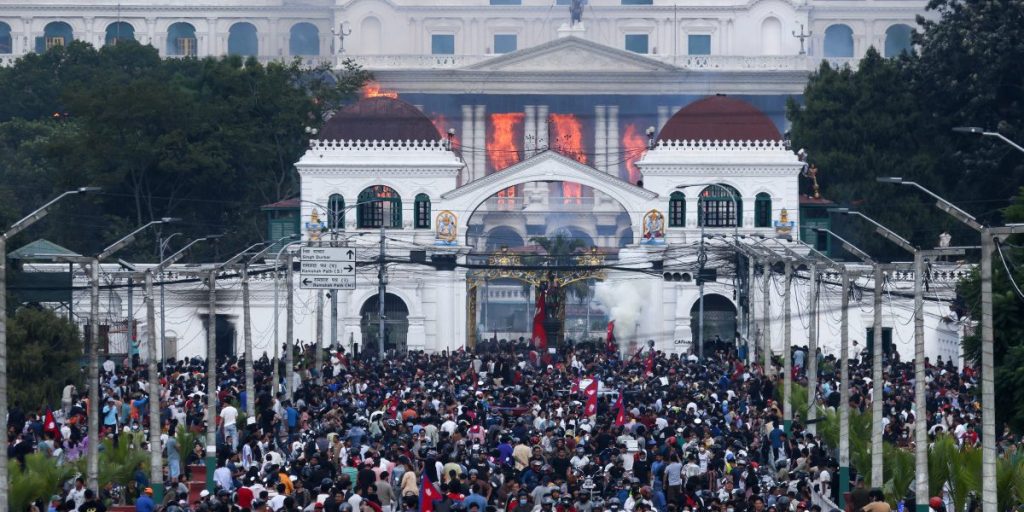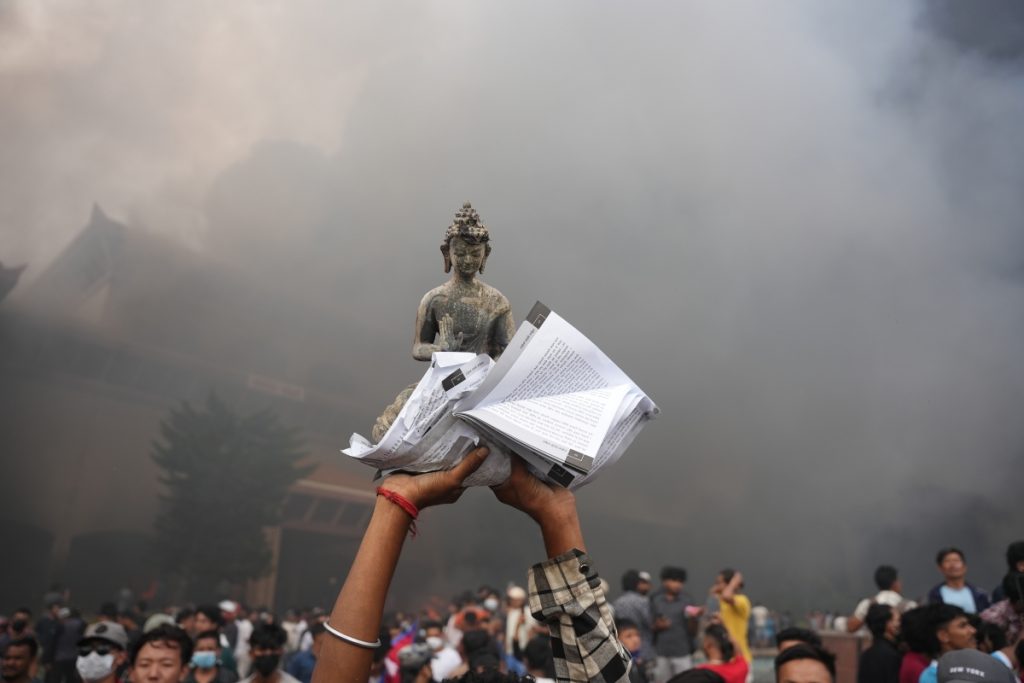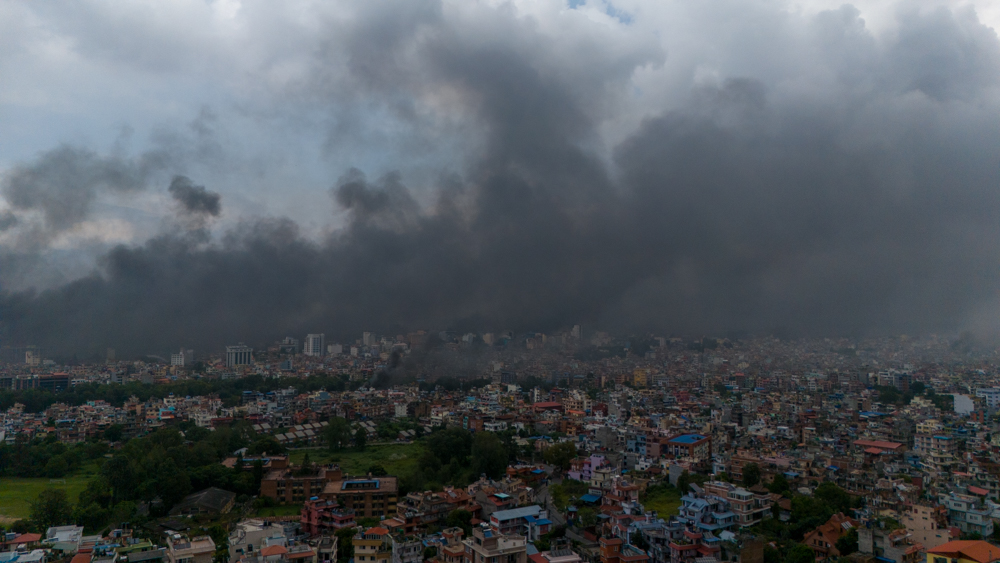From The Wire (Sep 17, 2025)
A protest triggered by the suspension of online platforms on September 8 spiralled into deadly violence, exposing the fragility of Nepal’s political order and forcing the resignation of Prime Minister K.P. Oli.

Events in the second week of September exposed how weak and mechanical the institutions of the Nepali state had become after years of political chaos and misgovernance. Beyond its other failings, the grand coalition of the Nepali Congress (NC) and the Communist Party of Nepal-UML, led by Prime Minister K.P. Oli, could not even implement a coherent plan to regulate social media platforms.
The government had issued repeated notices to international tech giants to appoint a ‘point person’ in Kathmandu, mainly to facilitate investigations into complaints and cybercrime though there may also have been the motive to control expression. TikTok and Viber complied, but others – including the US-based Facebook, Instagram, WhatsApp, Messenger, YouTube, X and LinkedIn – failed to comply with a sovereign decision issued to implement a Supreme Court order.
When the authorities announced the suspension of 26 platforms on September 4 pending registration, they failed to anticipate the fury of a populace suddenly deprived of tools on which their daily lives and livelihood depended.
The government also overlooked the dependence of more than four million Nepalis working abroad – mainly in the Gulf, Malaysia and India – whose vital link to families and news back home was abruptly severed. Meanwhile, the tech giants, despite maintaining offices across much of the Global South, continued to snub Nepal.
The resulting public frustration was captured by youngsters who organised a protest in mid-Kathmandu on September 8. What till then was a loosely formed group of the ‘Generation Z’ youths calling for revocation of the suspension of social media platforms, became larger with pertinent demands like good governance and transparency.
Importantly, they called out corruption in high places, uncontrolled despite successive media exposes over the years.
These investigations conducted by diligent mainstream journalists exposed land grabs, cooperative scams, gold smuggling, government appointments, human trafficking and a dastardly plan to make money off fake refugee registrations.
These widely publicised exposés found little traction in the courts and state administration and led to brewing resentment among the mass public, including the IT savvy youth. Lending fuel to the bitterness was the conspicuous consumption of the scions of some of the topmost leaders, including Maoist chief Pushpa Kamal Dahal (‘Prachanda’), Nepali Congress leader Sher Bahadur Deuba and others.
The coalition government’s overall failure of governance also fed public anger. Prime minister Oli was not quite the autocrat portrayed in populist rhetoric, though he came to embody a corrupt and dysfunctional system. His tenure was marked by accommodation to Nepali realities: an opportunistic Maoist leader waiting in the wings, the unsettled state of fledgling federalism, constant meddling from New Delhi and a weak, demoralised bureaucracy.
Despite his record of steering the polity past many political and geopolitical shoals in the past, Oli had grown increasingly remote from political counsel and prone to mistakes within his party and in government. Having bounced back into politics with double kidney transplants, his many Macchivelian victories may have made him feel invincible.
Dismissive of the Kathmandu intelligentsia, Oli ultimately evolved as a target of public derision.
Meanwhile, the coalition government failed to initiate the constitutional reforms that Oli and Deuba had pledged as the basis of their grand alliance. And for an astute politician who prided himself as an expert in feeling the public’s pulse, Oli appeared feckless in the face of algorithm-driven populism.

September 8
A turning point for the polity of modern-day Nepal thus arrived on September 8, as school children in uniform and college students gathered at the Maitighar Mandal roundabout in downtown Kathmandu, beside the Supreme Court.
Initially, the Gen Z protest proceeded smoothly and confined itself to the area assigned by the civil administration, but soon things began to go awry – what in retrospect appears to have been a pre-planned effort by actors who hijacked the rally from the youths, misusing the platform.
The demonstration lasted three hours, from 9 am till noon on Monday. Around then, a notice went out on the internet from a Gen Z account warning of infiltration: “Please exit safely and ASAP. There are too many vested groups rattling the mass. We successfully won the day. Let’s get home today safely.”
However, before that could happen, a section had moved towards the parliament building.
The police force failed in its duty. It did not apply the accepted measures of riot control – the sequencing of barricades, batons, teargas, water cannons and rubber bullets – and allowed the crowd to break through into the parliament premises, at which point the Special Task Force (STF) is said to have started aggressively firing live bullets.
The quantum of force was tragically out of proportion with the danger posed by the demonstrators. By evening, at least 19 young citizens were dead, and more than 300 wounded filled the hospitals.
As of now, the tragic tally stands at over 70 deaths and more than a thousand wounded.
As the next morning unfolded, it hardly seemed like a determined conspiracy to commandeer the youth demonstration; perhaps the quiet and determined rally had simply been taken over by the kind of anarchists found in every society, exploiting a power vacuum. But the violence that erupted later that day and the next pointed to a deliberate and long-planned attempt to overturn the constitutional order and parliamentary democracy.
Those who flooded the streets and stormed institutions likely included common criminals, party cadres, former Maoist guerrillas, renegade Gen Z members and monarchist-anarchists acting under internal and external influence.
The deaths at the hands of the police immediately created the conditions for the downfall of the NC-UML government. Politically, those who stood to benefit from the crippling of the two parties that had dominated the polity since 1990 included Balen Shah, the ambitious mayor of Kathmandu city, who keeps aloof from the press and relies on a tight and efficient circle of social media managers.
There is also the Rastriya Swatantra Party (RSP) of populist journalist-turned-politician Rabi Lamichhane, which would like to expand parliamentary strength through early elections, otherwise scheduled for November 2027.
Waiting in the wings are some independent neophyte politicians, as well as technocrats who have achieved populist fame, and who could step up amidst the unraveling of state institutions.
As far as the Maoist party is concerned, which has been progressively weakened electorally, any breakdown of the state howsoever achieved was welcome in order to take advantage of the situation.
Then there is the royalist Rastriya Prajatantra Party (RPP) which has functioned under the constitutional regime but seeks a return of kingship by dissolving the federal, secular, republican state structure.
Even with ‘constitutional monarchy’ in name, their revival would create such a powerful kingship that democracy and pluralism would be dead for all practical purposes.
Beyond the RPP, there are also radical monarchists and the Hindutva brigade backed by India’s RSS, which has opened an office in Kathmandu and ramped up its activities in Nepal’s hills and plains over the past half decade. Their effort would be to exploit the bedlam to foist a ‘Hindu state’ through restoration of monarchy, given that the efforts of the deposed king, Gyanendra, had proved a non-starter in March 2025.
Oli’s departure
At the beginning of September, Oli would have thought he was in total command of both, his party – CPN (UML) – and the larger polity. He returned from a China visit, after attending the Shanghai Cooperation Organisation summit in Tianjin and the September 3 tamasha of the Victory Day Parade in Beijing.
The prime minister had been energised by his meetings with Xi Jinping, Vladimir Putin and others, and in the formal bilateral meeting, he even found an opportunity to question President XI for having recently made a deal on cross-border trade with India through Lipulek Pass, which Nepal considers its territory.
On September 7, at a UML meet, Oli had pushed through changes to the party constitution – allowing him to run for a third term as chairman and past the age of 70 – both restrictions he had earlier insisted on. Later in the month, the prime minister was set to visit Bodh Gaya in Bihar for a long-expected meeting with Indian Prime Minister Narendra Modi.
Such was the height from which the prime minister was made to descend, resigning only two days later. Amidst all this, one must certainly ponder the geopolitical interests that may have been at play directly or indirectly in subsequent events.
There is Washington DC’s wariness of Beijing’s growing influence in Asia and worldwide, while the New Delhi establishment has been hostile towards Oli as the one who pushed through the revised Lipulek map through constitutional amendment, and stood firm amidst the Indian Blockade of 2015.
Oli had thought that Meta and other companies would ultimately concede to the government’s demand to open offices in Kathmandu as a couple others had done. He and the minister of information and communication, Prithvi Subba Gurung, did not expect the reaction of a populace that, besides using the social media platforms for communication, information and commercial needs, was by now addicted to the apps and smarted under the suspension.
Oli also miscalculated the timing of his resignation. Had he let go on the evening of September 8, the party machinery of the NC and UML could have come up with a new, younger, government leadership through parliament. The delay contributed to the power vacuum of the next day, delivering mayhem amidst the military’s inaction.
Given the unexplained absence of President Ramchandra Paudel, who should have set the narrative and assumed command under the Constitution, the central role in managing the rapid transition fell to the Nepal Army and its chief, General Ashok Raj Sigdel.
September 9
The arson and attacks of September 9 were nationwide and devastating, bringing the country to a dead halt, from roads and air services to tourism, and all aspects of governance and public life. The Supreme Court, Singha Durbar government secretariat and parliament were all torched.
The secretariat, built in 1908 and including the impressive baroque Gaddi Baithak hall, had been painstakingly restored over 10 years following the April 2015 earthquake.
The mob set fire to the president’s office of Shital Niwas, also restored post-earthquake. A complete listing of the arson and vandalism of public and private property will take more than a year to complete.
The papers of the Court, the secretariat and parliament went up in smoke, as did the holdings of land administration, internal revenue and customs offices. The loss of papers and records will make it that much harder to get the government and economy back and running. There was no authority in place throughout the horrific day, nor were communities able to challenge the mobs as they attacked structure after structure, home after home, working off a prepared checklist, using geolocation apps, walkie talkies and incendiary devices.
The Nepal Police and Armed Police Force were absent throughout, themselves besieged by the disruptors and their guns looted, while fire-fighters were blocked from doing even the little they could have. The great edifices of the government secretariat, judiciary and legislature, enduring symbols of the Nepali nation-state, were allowed to burn into the night with onlookers only taking selfies.
One nighttime drone footage over the Valley stood as mute witness, while on the ground the acrid smell of burnt wood, paper and plastic filled the air. For two days, even the monsoon refused to come to the rescue, leaving fires and embers to burn themselves out.

Party offices, newsrooms, schools, hotels, malls, cable cars, police posts, auto showrooms were targeted. The Bhat-Bhateni supermarket is a successful chain with 27 multi-storied establishments around the country; only seven are left standing. Even as many residences, big and small, official and private, linked to politicians, businessmen and public personalities were razed, it is significant that the former royal palace of Narayanhiti, and the Nirmal Niwas residence of ex-king Gyanendra were left untouched.
While the Nepal Army generals would have known that the September 8 killings would deliver an eruption of violence the next day, they seemed unprepared or unconcerned. The Army took all of September 9 before it woke up to the need to patrol the streets, coming out only at 10 PM that day, by which time, the agitators had completed their task at leisure.
The military headquarters at Bhadrakali stands on a low hill overlooking the parliament, Supreme Court and Singha Durbar, all of them within a radius of two kilometres. There is a battalion stationed within the Singha Durbar premises which should have protected all three institutions. The soldiers did not move – it may have been intentional or incompetence – while the public wept.
By way of defence, Army officers have told members of the political class that the COAS met the likes of the royalist Durga Prasai and Gen Z representatives in order to shield them from the President, who is officially the Nepal Army’s supreme commander-in-chief (Paramaadhipati).
As for the inability of the soldiers to control the arson and looting, they point to the protocols that govern the military’s deployment, which is also what they did during the initial years of the Maoist insurgency when they stayed in the barracks. Further, they maintain that had the soldiers actually acted against the crowds, there would have been uncountable deaths.
The word is that over at his official Baluwatar residence, PM Oli was committed to sitting out the crisis, but decided abruptly to step down when he was informed by the army that he no longer had its support. The veracity of this information will have to be investigated and understood in the days to come.
Amidst the melee, the need for a proper and public transfer of power was neglected. The mobs were emboldened in the ensuing absence of authority.
Sher Bahadur Deuba and his spouse and foreign minister Arzu Deuba (till the prime minister’s resignation), were badly beaten in their residence and dragged out by enraged rioters, who gleefully shared heart-rending videos. Injured, they were finally rescued by security personnel.
Other ministers and officials were humiliated in public while they lost their properties.
As an observer said, “By the end of the day, the government was broken and the leaders homeless.”
Even at the time of writing this article, with an interim government announced, the public does not know the whereabouts of the ex-prime minister and several other ministers.
Did a matter of providing personal security evolve into undeclared house arrest, as was also the case with the chief ministers of all seven provinces?
RSP leader Ravi Lamichhane, being investigated for fraud in cooperative companies, was spirited out of Nakkhu Jail by invading supporters who led to the ‘liberation’ of all the inmates. According to police statistics, 14,507 prisoners escaped from prisons all over the country, triggered by the Lamichhane episode, and only 455 have been brought back in.
Among the thousands who fled was the mastermind of a 2012 bomb blast in Janakpur, which killed five Maithili activists, an Indian national serving time for kidnapping and ransom and a Maoist former minister are being investigated in the fake refugee scam.
Convicted murderers, rapists and all kinds of felons are walking freely on Nepal’s bylanes and communities, some of them bearing looted arms. With the mass exit of prisoners, Nepal’s society has been made insecure from an unexpected source.
If the interim government is unable to immediately manage law and order through the police force, communities from all over the country will start taking charge of their own security, which will have its own dangers of vigilantism.
Amid the smoke and ruins, the survival of Nepal’s constitution itself is suddenly in question.
Kanak Mani Dixit is a writer and Founding Editor of Himal Southasian magazine as well as a civil rights activist based in Kathmandu Valley. kanakmanidixit.com
This is the first part of a two-part series on the Nepal interregnum.
